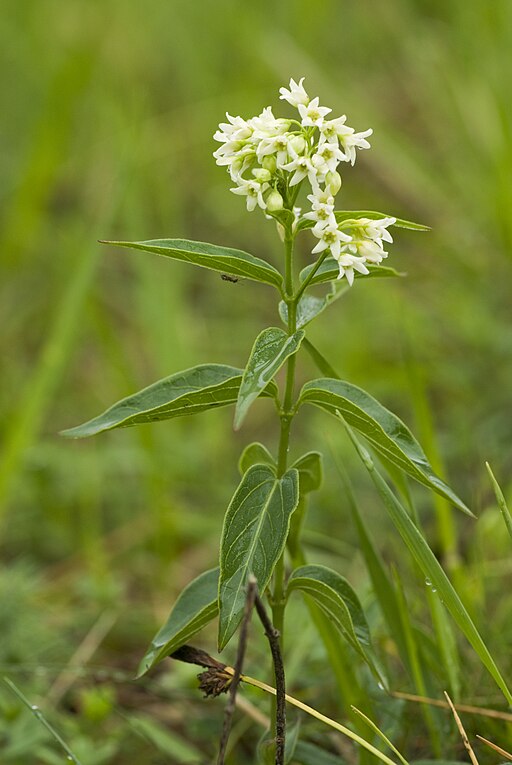Classification System: APG IV
Superregnum: Eukaryota
Regnum: Plantae
Cladus: Angiosperms
Cladus: Eudicots
Cladus: Core eudicots
Cladus: Asterids
Cladus: Lamiids
Ordo: Gentianales
Familia: Apocynaceae
Subfamilia: Asclepiadoideae
Tribus: Asclepiadeae
Subtribus: Tylophorinae
Genus: Vincetoxicum
Species: Vincetoxicum hirundinaria
Subspecies: V. h. subsp. adriaticum – V. h. subsp. apodum – V. h. subsp. contiguum – V. h. subsp. cretaceum – V. h. subsp. hirundinaria – V. h. subsp. intermedium – V. h. subsp. jailicola – V. h. subsp. lusitanicum – V. h. subsp. luteolum – V. h. subsp. nivale – V. h. subsp. stepposum
Name
Vincetoxicum hirundinaria Medik., Hist. & Commentat. Acad. Elect. Sci. Theod.-Palat. 6:404. 1790.
Synonyms
Basionym
Asclepias vincetoxicum L., Sp. Pl.: 216 (1753).
Homotypic
Vincetoxicum officinale Moench, Methodus: 717 (1794), nom. superfl.
Asclepias toxicaria Salisb., Prodr. Stirp. Chap. Allerton: 150 (1796), nom. superfl.
Cynanchum vincetoxicum (L.) Pers., Syn. Pl. 1: 274 (1805).
Alexitoxicon officinale St.-Lag., Ann. Soc. Bot. Lyon 7: 120 (1880), nom. superfl.
Vincetoxicum vincetoxicum (L.) H.Karst., Deut. Fl.: 1030 (1883), not validly publ.
Vincetoxicum alpinum Farrer, Engl. Rock Gard. 2: 443 (1919), nom. superfl.
Antitoxicum officinale Pobed. in V.L.Komarov (ed.), Fl. URSS 18: 697 (1952), nom. superfl.
Alexitoxicon vincetoxicum (L.) H.P.Fuchs, Verh. Naturf. Ges. Basel 72: 346 (1961).
References
Medikus, F.K.. 1790. [Historia et Commentationes Academiae Electoralis Scientiarum et Elegantiorum Litterarum Theodoro-Palatinae]]. Mannheim 6:404. 1790.
Links
Govaerts, R. et al. 2018. Vincetoxicum hirundinaria in World Checklist of Selected Plant Families. The Board of Trustees of the Royal Botanic Gardens, Kew. Published on the internet. Accessed: 2018 Oct. 07. Reference page.
Hassler, M. 2018. Vincetoxicum hirundinaria. World Plants: Synonymic Checklists of the Vascular Plants of the World In: Roskovh, Y., Abucay, L., Orrell, T., Nicolson, D., Bailly, N., Kirk, P., Bourgoin, T., DeWalt, R.E., Decock, W., De Wever, A., Nieukerken, E. van, Zarucchi, J. & Penev, L., eds. 2018. Species 2000 & ITIS Catalogue of Life. Published on the internet. Accessed: 2018 Oct. 07. Reference page.
International Plant Names Index. 2018. Vincetoxicum hirundinaria. Published online. Accessed: Oct. 07 2018.
The Plant List 2013. Vincetoxicum hirundinaria in The Plant List Version 1.1. Published on the internet. Accessed: 2018 Oct. 07.
Tropicos.org 2018. Vincetoxicum hirundinaria. Missouri Botanical Garden. Published on the internet. Accessed: 2018 Oct. 07.
USDA, ARS, Germplasm Resources Information Network. Vincetoxicum hirundinaria in the Germplasm Resources Information Network (GRIN), U.S. Department of Agriculture Agricultural Research Service. Accessed: 09-Oct-10.
Vernacular names
العربية: غلقى مخزنية
čeština: tolita lékařská
dansk: Almindelig Svalerod, Svalerod
Deutsch: Schwalbenwurz, Sankt-Lorenzkraut, Sankt-Lorenz-Wurzel
English: white swallow-wort
español: vencetósigo, centósigo, hirundinaria, matatósigo, mataveneno, pimiento de monte, vencetorigo, vencetosigo, vence-veneno, vincetósigo, vincetóxico
eesti: Lood-angervars
euskara: Piper-belar piseragile
suomi: Kalliokäärmeenpistonyrtti, käärmeenpistonyrtti
français: Dompte-venin officinal
hornjoserbsce: Běły łastojčnik
italiano: Cynanchum vincetoxicum
lietuvių: Šlakinė kregždūnė
Nederlands: Witte engbloem
polski: Ciemiężyk białokwiatowy
português: erva-contraveneno
русский: Ластовень ласточкин
slovenčina: luskáč lekársky
svenska: Tulkört, Tilkört, Ormstingsrot, Tulkegräs, Rylgräs, Svalegräs, Svaleört, Tulkgräs, Tulkagräs, Svalerot, Horskonung
中文(简体): 催吐白前
中文(繁體): 催吐白前
中文(臺灣): 催吐白前
中文: 催吐白前
Vincetoxicum hirundinaria, commonly named white swallow-wort, is a long-lived herbaceous perennial of the genus Vincetoxicum in the family Apocynaceae.
Etymology
The generic name Vincetoxicum, in Latin meaning ‘conqueror of poison’, derives from the traditional use of this plant has as an antidote to poisons.[2] The Latin species name hirundinaria (from hirundo, meaning swallow) and the common name white swallow-wort refer to its seedpods, that are reminiscent of a swallow's wing, or tail.
Description
Vincetoxicum hirundinaria can reach a height of 30–70 centimetres (12–28 in). Stem is erect, stout and glabrous. Flowers in whorls form a raceme. They have a diamenter of about 1 centimetre (0.39 in). Corolla has five white petals. Calyx is composed by five fused, sharp-pointed sepals. Leaves are opposite, ovate to lanceolate and short-stalked. Fruits reach a length of about 5 cm and contain many seeds showing a tuft of white hairs. Flowering time lasts from June to the end of July.[2]
Distribution and habitat
This species is native to cliffs and slopes, especially in calcareous soils, of continental Eurasia (including some Baltic islands).[3] There are introduced populations in North America (Ontario, Michigan, and New York).[1] It is not present in Great Britain and Ireland.
Human culture
Vincetoxicum hirundinaria is a venomous plant traditionally used in treating diseases and in magic. The plant was mentioned by Pedanius Dioscorides as a traditional plant used by Dacians and known as the "herb of animals", believed to open any locked door.[4]
Gallery
Close-up on flowers
Seeds and hairy wool
Fruit and seeds
Illustration
References
"Cynanchum vincetoxicum (L.) Pers".
Nature Gate
Leimu, R (Jan 2004). "Variation in the mating system of Vincetoxicum hirundinaria (Asclepiadaceae) in peripheral island populations" (Free full text). Annals of Botany. 93 (1): 107–13. doi:10.1093/aob/mch012. ISSN 0305-7364. PMC 4242266. PMID 14678943.
Bucurescu, Adrian (22 August 2012). "Iarba fiarelor". The Epoch Times, Romania. Retrieved 24 March 2013.
Retrieved from "http://en.wikipedia.org/"
All text is available under the terms of the GNU Free Documentation License


